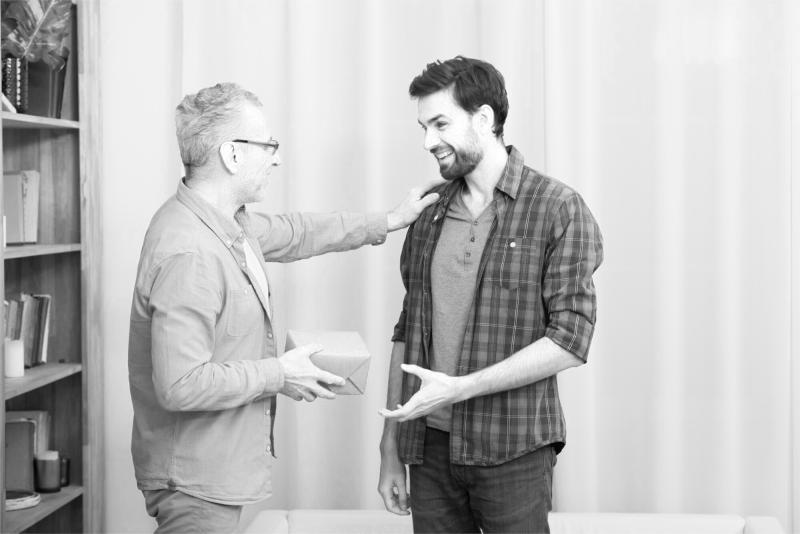Everyone wants to be happy, but what is happiness actually?
In a highly individualized culture, happiness has often been associated with personal gain, success, achievement, and acquiring more. However, perhaps you’ve seen many people gaining more than others, but they don’t seem any happier. So, what is happiness truly?
This article will explore the lesser-discussed path to happiness: giving. It highlights how generosity can lead to more profound and longer-lasting happiness, challenging the common belief that happiness primarily lies in personal achievement and material gain.
Learn how the real secret to happiness lies in what you give, not what you get.
Rethinking the pursuit of happiness
When asked what makes them happy, people often think about earning more money or getting new things. Perhaps, you do too. Material gain, indeed, can induce positive emotion that makes your day.
Say you’re buying a new phone or treating yourself to a luxury item. These can spark excitement and feelings of joy, but the thrill fades quickly. What remains is often a sense of emptiness because these moments lack deeper meaning.
When you lay your happiness on mere possession or achievements, there’s always a next level to reach: more money, more success, or more status. Instead of feeling satisfied, you will feel restless and frustrated, as if happiness is always out of reach.
The good news is, there’s another way. When you turn your attention from “What can I get?” to “What can I give?“, something powerful happens: generosity creates lasting joy.
How acts of generosity lead to lasting happiness
Generosity is an act of giving one’s personal resources to others without expecting any returns. Generous acts can take many forms, from making charitable donations and volunteering to informal actions such as providing assistance to others or sharing food.
When talking about giving or helping others, people often assume that it only benefits the recipients. The truth is, those who engage in prosocial behavior can experience pleasure from doing so, even in a more enduring form.
Why and how?
Scroll down here to learn more about the psychology of giving and reap the benefits of charity acts.
Emotional reward of giving
In a study involving more than 1,700 participants, university students were randomly assigned to purchase treats either for themselves or a sick child. The results were striking: those who spent money on others reported feeling happier.
This study suggests that prosocial spending yields greater emotional rewards than self-interest spending.
However, not all generous acts lead to happiness. To truly enjoy the emotional benefits of giving, certain conditions must be met, and these can be understood through the lens of Self-Determination Theory (SDT).
According to SDT, human beings have three basic psychological needs: autonomy, competence, and relatedness. When these needs are fulfilled, people report greater well-being and lasting happiness.
In this sense, generosity will be most potent when it fulfills these needs:
- Giving voluntarily (autonomy): Giving should feel like your own decision, whether you choose to donate, decide how much to give, or select who to help. When it is freely chosen, the joy of generosity is stronger.
- Making an impact (competence): When you are aware of the difference you make through your actions, you tend to feel happier and more fulfilled, as it indicates your competence in creating a positive impact.
- Building connection (relatedness): Acts of giving that strengthen social bonds — by deepening relationships or fostering a sense of belonging — bring especially enduring satisfaction.
In short, generosity leads to longer-lasting happiness when it is freely chosen, effective, and meaningful. But what does it look like in everyday life? The section below will explore some real-world examples of giving and how it nurtures both others’ and your well-being.
Examples of acts of generosity
Generosity can take many forms, from everyday acts of kindness to organized efforts that positively impact communities. Although people often associate giving with financial generosity, this is not always the case.
Many people help others in various ways, aside from giving money. It can be as simple as giving your time through volunteering, donating blood or organs, or sharing food with those in need.
A study shows that hours spent in volunteering activities significantly boost psychological well-being. Through volunteering, you experience the emotional glow as you act in line with your values. It provides meaning, purpose, and a sense of competency for creating a positive impact on your community.
Moreover, the connection you build between you and the receiver fosters your sense of social belonging. These positive feelings will then culminate in a sense of gratitude for what life has offered to you.
Additionally, generosity doesn’t always have to affect the larger community. Even a small kindness can promote happiness. For instance, giving someone an ice cream as a gift can induce a positive affect and create a moment of joy.
This suggests that even a straightforward and effortful act of giving can help sustain happiness.
Generosity and happiness in everyday life
A question arises when it comes to incorporating giving into daily life. What if you don’t have enough money to donate or time to volunteer? Can it still be applied in everyday life?
The answer is: Sure, you can.
An act of giving doesn’t have to be big; even small gestures, such as saying hello to your neighborhood, offering a helping hand, or holding a door for a stranger, can be a powerful way to exercise generosity. These spontaneous acts of generosity are often called Random Acts of Kindness (RAKs).
Showing kindness to others leads to a more positive perception of others, fostering a sense of cooperation within your community. At the same time, it encourages you to appreciate the advantages you have in life, leading to greater psychological well-being.
Read more: How Acts of Kindness Improve Mental Health
How to give in a way that nourishes you
Remember that not all generous actions lead to greater emotional rewards. Thus, it is essential to equip yourself with evidence-based practice to reap the positive effects of giving. Here are a few practices to consider:
Give in alignment with your values
To experience the emotional benefits of giving, you need to reflect on what truly matters to you.
This means looking into what you truly care about and aligning your actions with your calling.
You may care about education, nature, or children. Start by noticing which social issues intrigue you most and think about the best way to help people in those areas.
When you give in ways that match your values, the joy lasts longer. Think of it as living your principles through kindness.
Avoid burnout through mindful giving
Generosity should be a soul-building path, not a soul-draining one. If you feel guilty or pressured to keep giving, you risk emotional exhaustion instead of joy.
Be gentle with yourself by setting boundaries and giving at a pace that feels sustainable. Follow these actionable steps to set boundaries on giving practices:
- Define your limit. Decide how much time, money, and energy you can realistically give without straining yourself.
- Prioritize what matters to you. Participating in all charity acts must be draining. Focus on the area you value the most rather than saying “yes” to everything.
- Learn to say “no”. You don’t have the obligation to give your resources to literally everything. Practice saying “no” gracefully when it’s beyond your capacity.
- Balance giving with self-care. Giving excessively won’t lead you to lasting joy; balance will. So, every time you feel like you’re starting to lose your spark in giving, give yourself a rest.
- Reflect regularly. Check with yourself, does your giving uplift or drain your energy? Adjust your commitment accordingly.
Remember, generosity should uplift you, not wear you down.
Reflect on what giving teaches you
Every act of kindness carries a lesson. When you pause to reflect, you discover how giving shapes your mood, outlook, and sense of purpose.
Journaling can help you notice these lessons more deeply. Here are some steps you can try:
- Think about a recent generous act. Write down what you did, in what form you shared your generosity, and with whom. This serves as a reminder and fosters a sense of gratitude.
- Reflect on the impact. Notice how your act of kindness affected others. Were they appreciative? Did something positive happen afterward?
- Pay attention to your emotions. How did you feel after giving? Did you notice a “glow” of kindness? Why do you think that happened?
- Be creative with your giving. Repeating the same acts can make them feel routine. Consider new ways to give so the experience remains fresh and meaningful.
Notice the ripple effect of giving
Your generosity doesn’t end with you. One kind act often inspires others to do the same. By giving, you help create a chain of kindness that stretches further than you might see. Knowing you started that ripple brings its own quiet joy.
To notice this, observe how your actions affect others beyond the immediate moment.
For instance, when you hold the door for a stranger at a minimarket, pay attention not only to their reaction but also to whether they, in turn, extend a helping hand to someone else. Notice whether your actions spark positive emotions in your surroundings.
On a community level, you can also reflect on whether a charity you organized inspired others. Did people around you begin to take similar actions? Did your effort encourage more good deeds to grow from it?
In conclusion
Society often tells you that happiness comes from what you achieve or acquire. Yet many people discover that even after gaining more, they still feel a sense of emptiness.
Generosity offers a different path. When you shift your focus from what you can get to what you can give, you begin to nurture your soul with meaning and purpose.
Research and lived experiences show that giving — when done with intention and heart—creates joy that lasts longer than any material success. It is through generosity that happiness becomes not just a fleeting feeling, but a fulfilling way of life.
So, go out there and spread kindness however you can.
If you want to see more resources on charity, check out the Happiness Science Labs. The lab uses the research of the Institute for Life Management Science to produce courses, certifications, podcasts, videos, and other tools. Visit the Happiness Science Labs today.
Photo by Freepik


